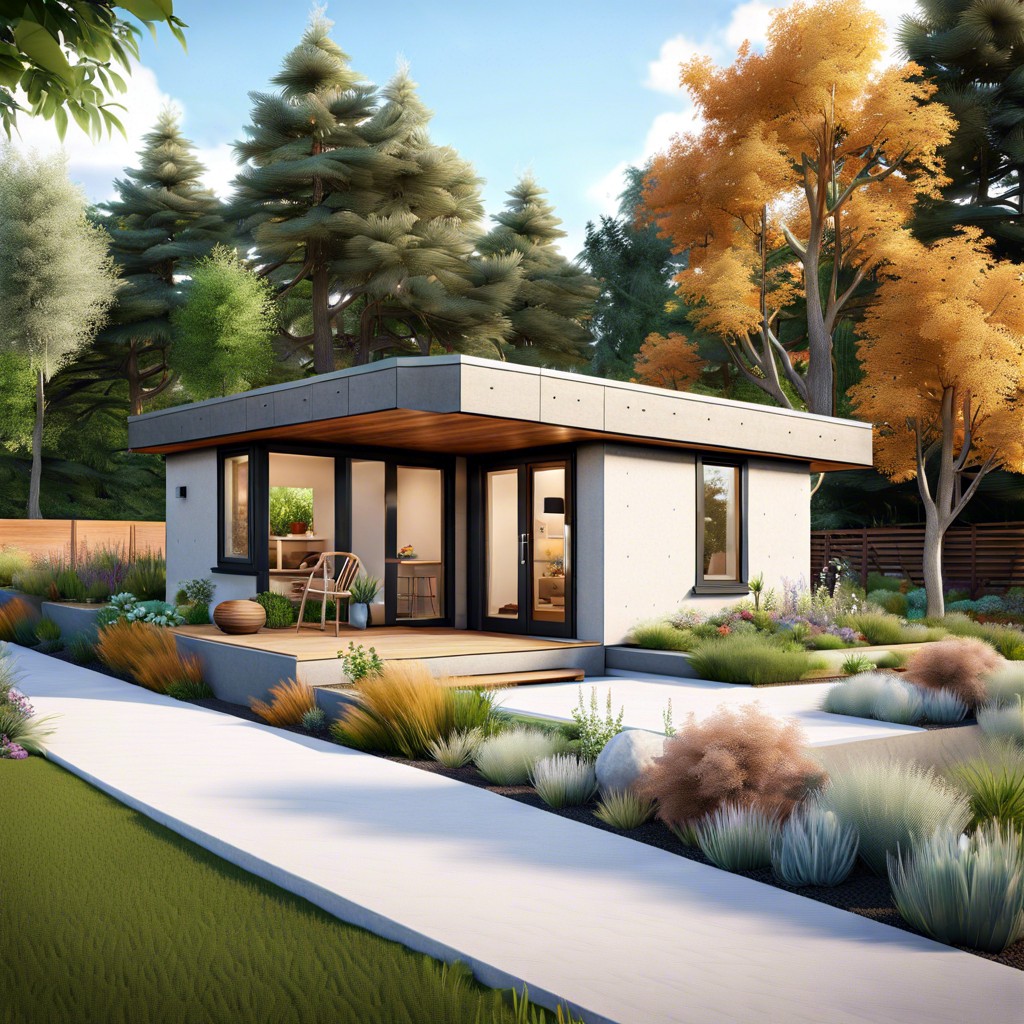Last updated on
In this article, you’ll learn about the different types of foundations suitable for an accessory dwelling unit (ADU) and what to consider when choosing the best option for your project.
Key takeaways:
- A solid foundation ensures stability, cost-efficiency, and comfort for your ADU.
- Hidden costs for sitework and utilities can significantly impact your budget.
- Consider the capacity, permits, costs, maintenance, and environmental impact of your septic system.
- Properly designed footings are essential for long-term stability and compliance.
- Insulation in the foundation helps maintain temperature, prevent moisture issues, and reduce noise.
Why Your ADU’s Foundation Matters: Stability, Cost, and Livability

The foundation underpinning an ADU is paramount for various reasons. Primarily, it’s the unsung hero that ensures the structure’s stability over time. From the soil type to the weight of the building, the right foundation keeps your investment standing strong against the elements.
Cost is another significant factor influenced by foundation choice. A solid concrete foundation may have higher upfront costs, but it could save you money in repairs and maintenance in the long run. Conversely, a less sturdy foundation might be cheaper initially but could lead to costly issues if it fails to withstand environmental stresses.
Lastly, the type of foundation you choose directly affects livability within the ADU. A well-insulated and moisture-resistant foundation not only contributes to a more comfortable living space but also to better indoor air quality. A foundation that fends off dampness and temperature extremes can play a pivotal role in creating a cozy home all year round.
Understanding these foundation fundamentals will guide you in decisions that impact the longevity, cost-efficiency, and homeliness of your accessory dwelling unit.
ADU Sitework & Utility Costs: 10 Hidden Costs
Before embarking on an ADU project, it is crucial to understand the potential hidden costs associated with sitework and utilities. These are usually overlooked in initial budgets but play a significant role in the overall expense.
- Soil Testing: Prior to construction, soil tests might be required to ensure the ground can support your ADU. This test can add an unexpected cost.
- Excavation: Depending on the land’s characteristics, excavation may be more complicated and costly than anticipated, particularly if large rocks or a high water table are present.
- Utility Connections: Extending existing utility lines to your ADU or installing new ones can be expensive, especially if your unit is far from the main house or street connections.
- Impact Fees: Local municipalities may charge fees for connecting to water, sewer, or electrical services. These fees help cover the cost of expanding city services to accommodate your new structure.
- Tree Removal: Clearing the land for your ADU might involve removing trees, which can be costly, especially if they are large or if multiple trees are involved.
- Landscaping Restoration: After construction, the surrounding land might need restoration or new landscaping, which should be accounted for in your budget.
- Drainage Solutions: Proper drainage around your ADU is essential to prevent water damage, necessitating additional expenses for grading, gutters, or French drains.
- Surveys: A property survey might be necessary to establish the exact boundaries or topography, which is critical for legal and construction purposes.
- Erosion Control: You may need to implement erosion control measures during construction which could increase site preparation costs.
- Permitting Fees: Don’t forget to factor in the cost of various permits required for construction, which can vary widely depending on your location.
Anticipating these hidden costs when planning your ADU can save you from unwelcome financial surprises, ensuring a smoother building process.
Septic System for an ADU: What You Need to Know
Incorporating an Accessory Dwelling Unit (ADU) on your property may necessitate a critical look at your existing septic system. Here’s what to keep in mind:
Capacity: Your current septic system was designed for a specific load based on the number of bedrooms in your main house. Adding an ADU could exceed its handling capacity, warranting an upgrade or a new system. Before you build, consult a septic system professional to determine if expansion is possible and what it entails.
Permits: Modifying or installing a new septic system requires approval from local health departments. Submit detailed plans of your ADU, including the expected increase in wastewater, to acquire the necessary permits.
Costs: Upgrading a septic system is often a substantial investment. It can range from a few thousand dollars for minor improvements to tens of thousands for a new or more complex system like a mound system or aerobic treatment unit.
Maintenance: An expanded or new system comes with its own maintenance demands. Regular inspections, pumping, and potential repairs should be factored into your long-term budget to ensure functionality and compliance with environmental regulations.
Environmental Impact: Adding an ADU can mean adding strain to your septic system and, by extension, the surrounding land. Modern systems are designed to minimize environmental impact, but it’s crucial to follow best practices to protect groundwater and soil quality.
By assessing these factors, you can ensure that your ADU project is both viable and sustainable, promoting responsible homeownership and community development.
Foundation Footings
The depth and width of foundation footings are non-negotiable essentials for ensuring the long-term stability of your ADU. Designed to spread the structural load over a broader area, proper footings prevent sinking and shifting that could otherwise lead to costly damage.
Climate plays a pivotal role. In colder regions, footings must extend below the frost line to avoid upheaval due to freeze-thaw cycles. Conversely, in areas with expansive soils, broader footings distribute the load, helping prevent movement as soils expand and contract.
The footing design is part of a symbiotic relationship with the ADU’s overall structural plan. Engineers factor in soil analysis, building size, and the anticipated load when calculating footing dimensions. These precise measurements are a crucial step to ensure safety and compliance with local building codes.
For an ADU, considering the future is wise when pouring footings. Even if expansion isn’t immediately on the cards, a solid and slightly more extensive footing can accommodate potential growth, saving you time and resources.
Remember, while the above ground aesthetics of an ADU captures attention, it’s the unseen foundation footings that are silently working to ensure its lasting presence. Investing in them pays dividends in the form of peace of mind and structural integrity.
Insulation
Selecting the right insulation for your ADU foundation is crucial for several reasons.
Firstly, insulation helps in maintaining a consistent indoor temperature, reducing the heating and cooling costs throughout the year. Think of insulation as a thermal barrier; it keeps the warmth in during winter and the heat out in summer. That translates into a more comfortable living space for occupants and can significantly lower energy bills.
Secondly, adequate insulation plays a pivotal role in preventing moisture problems. Without proper insulation, condensation can occur, leading to mold and mildew, which can compromise the ADU’s air quality and structural integrity. Properly insulating the foundation keeps the moisture at bay, ensuring the indoor environment remains healthy and the structure durable.
Additionally, insulation can serve as a form of soundproofing, minimizing the transmission of noise from outside into the living space. For an ADU that might be located close to the main house or near a busy street, this can be an invaluable feature, providing a peaceful retreat for its inhabitants.
There are various types of foundation insulation available, such as rigid foam boards and spray foam, each with its specific properties and installation methods. Choosing the correct type depends on your climate, the ADU’s design, and local building codes. It’s advisable to consult with a professional to determine the best insulation strategy for your ADU to ensure you achieve comfort, cost-efficiency, and compliance with all regulations.
Related reading:
Table of Contents





